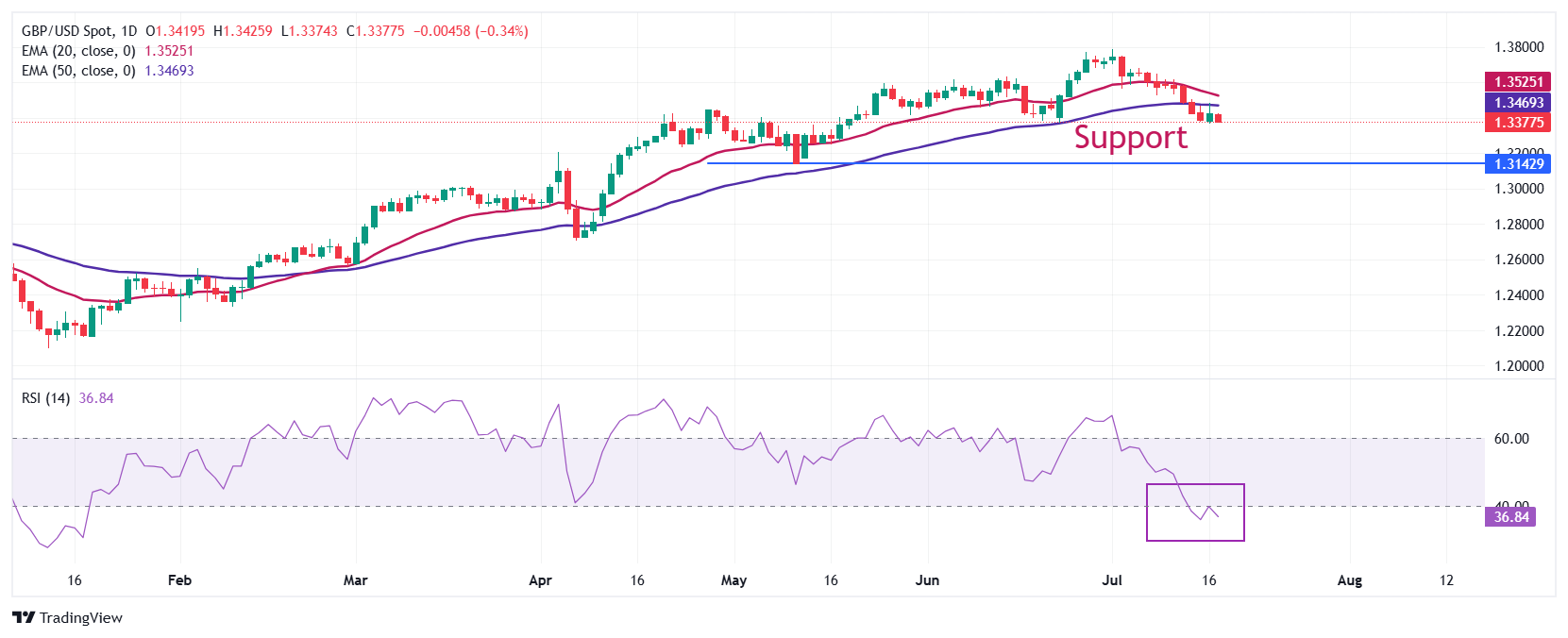- The Pound Sterling recoups some of its early losses against the US Dollar on mixed UK employment data for the three-months ending May.
- UK wage growth slowed down, as expected, and the ILO Unemployment Rate accelerated to 4.7%.
- US President Trump denied reports stating that he will fire Fed’s Powell soon.
The Pound Sterling (GBP) trades higher against its major peers, except for the US Dollar, on Thursday. The British currency gains after a mixed United Kingdom (UK) job market report, which showed more employment levels but also a higher unemployment rate.
The ILO Unemployment Rate has increased to 4.7%, above expectations and the prior reading of 4.6%. However, the report showed that the number of workers added by employers in the three-months ending May came in higher at 134K than the prior reading of 89K.
Investors were anticipating a weak set of employment numbers as the latest survey from the Recruitment and Employment Confederation trade body and accountants KPMG signaled that the availability of individuals for jobs has increased significantly.
The hiring had been slowed down in recent months as business owners were offsetting the impact of an increase in employers’ contribution to social security schemes announced by the Chancellor of the Exchequer in the Autumn Statement.
Average Earnings (Excluding and Including) bonuses rose by 5% on year, majorly in line with market expectations, but have slowed down from readings seen in the three-months ending April.
Easing Average Earnings, a key measure of wage growth, is expected to offer slight relief to Bank of England (BoE) officials, who have become worried about the inflation outlook, following the release of the hotter-than-projected Consumer Price Index (CPI) report on Wednesday. The report showed that both headline and the core CPI rose at a faster pace on year to 3.6% and 3.7%, respectively.
British Pound PRICE Today
The table below shows the percentage change of British Pound (GBP) against listed major currencies today. British Pound was the strongest against the Australian Dollar.
| USD | EUR | GBP | JPY | CAD | AUD | NZD | CHF | |
|---|---|---|---|---|---|---|---|---|
| USD | 0.47% | 0.17% | 0.55% | 0.54% | 0.96% | 0.49% | 0.43% | |
| EUR | -0.47% | -0.29% | 0.07% | 0.10% | 0.51% | 0.05% | -0.01% | |
| GBP | -0.17% | 0.29% | 0.38% | 0.37% | 0.78% | 0.32% | 0.26% | |
| JPY | -0.55% | -0.07% | -0.38% | -0.05% | 0.36% | -0.06% | -0.13% | |
| CAD | -0.54% | -0.10% | -0.37% | 0.05% | 0.50% | -0.05% | -0.11% | |
| AUD | -0.96% | -0.51% | -0.78% | -0.36% | -0.50% | -0.54% | -0.52% | |
| NZD | -0.49% | -0.05% | -0.32% | 0.06% | 0.05% | 0.54% | -0.06% | |
| CHF | -0.43% | 0.00% | -0.26% | 0.13% | 0.11% | 0.52% | 0.06% |
The heat map shows percentage changes of major currencies against each other. The base currency is picked from the left column, while the quote currency is picked from the top row. For example, if you pick the British Pound from the left column and move along the horizontal line to the US Dollar, the percentage change displayed in the box will represent GBP (base)/USD (quote).
Daily digest market movers: Pound Sterling weakens against US Dollar
- The Pound Sterling claws back some of its early losses and is down 0.13% against the US Dollar on Thursday. The GBP/USD pair rebounds slightly to near 1.3400 after attracting slight bids near an almost two-month low of 1.3370. The Cable trades lower as the US Dollar gains, following United States (US) President Donald Trump’s denial to reports stating that he will fire Federal Reserve (Fed) Chair Jerome Powell sooner.
- At the time of writing, the US Dollar Index (DXY), which tracks the Greenback’s value against six major currencies, trades 0.5% higher to near 98.80.
- US President Trump acknowledged in an interview with the Real America’s Voice network on Wednesday that Powell’s dismissal by him could cause upheaval in markets. “I’d love if he wants to resign, that would be up to him. They say it would disrupt the market if I did,” Trump said.
- The report from Reuters on Wednesday stating that Trump received a positive response after polling some Republican lawmakers on firing Powell led to a sharp decline in the US Dollar and US equity markets.
- Meanwhile, comments from a couple of Fed officials pointing to de-anchoring consumer inflation expectations have also strengthened the US Dollar. New York Federal Reserve (Fed) Bank President John Williams and Atlanta Fed Bank President Raphael Bostic warned that the impact of tariffs on inflation has just started building up, and it will accelerate going ahead.
- “It’s early days for impact of tariffs on economy, which is modest so far but will increase over time,” New York Fed Bank President John Williams said in a speech at the New York Association for Business Economics on Wednesday. He warned that tariffs should boost inflation by “one percentage point rest of 2025 into 2026”.
- Going forward, investors will focus on the US Retail Sales data, a key indicator of consumer spending, for June, which will be published at 12:30 GMT. The consumer spending measure is expected to have grown by 0.1% after declining 0.9% in May.
Technical Analysis: Pound Sterling sees downside to near 1.3200

The Pound Sterling declines to near 1.3370 against the US Dollar on Thursday, the lowest level in almost two months. The near-term trend of the GBP/USD pair is bearish as it trades below the 20-day and 50-day Exponential Moving Averages (EMAs), which trade around 1.3525 and 1.3470, respectively.
The 14-day Relative Strength Index (RSI) oscillates below 40.00, indicating a strong bearish momentum.
Looking down, the May 12 low of 1.3140 will act as a key support zone. On the upside, the July 11 high around 1.3585 will act as a key barrier.
Employment FAQs
Labor market conditions are a key element to assess the health of an economy and thus a key driver for currency valuation. High employment, or low unemployment, has positive implications for consumer spending and thus economic growth, boosting the value of the local currency. Moreover, a very tight labor market – a situation in which there is a shortage of workers to fill open positions – can also have implications on inflation levels and thus monetary policy as low labor supply and high demand leads to higher wages.
The pace at which salaries are growing in an economy is key for policymakers. High wage growth means that households have more money to spend, usually leading to price increases in consumer goods. In contrast to more volatile sources of inflation such as energy prices, wage growth is seen as a key component of underlying and persisting inflation as salary increases are unlikely to be undone. Central banks around the world pay close attention to wage growth data when deciding on monetary policy.
The weight that each central bank assigns to labor market conditions depends on its objectives. Some central banks explicitly have mandates related to the labor market beyond controlling inflation levels. The US Federal Reserve (Fed), for example, has the dual mandate of promoting maximum employment and stable prices. Meanwhile, the European Central Bank’s (ECB) sole mandate is to keep inflation under control. Still, and despite whatever mandates they have, labor market conditions are an important factor for policymakers given its significance as a gauge of the health of the economy and their direct relationship to inflation.







